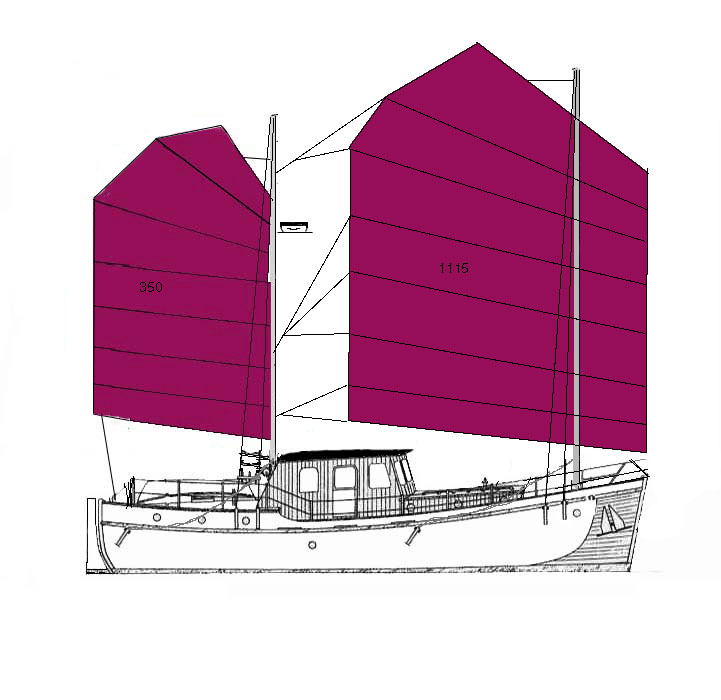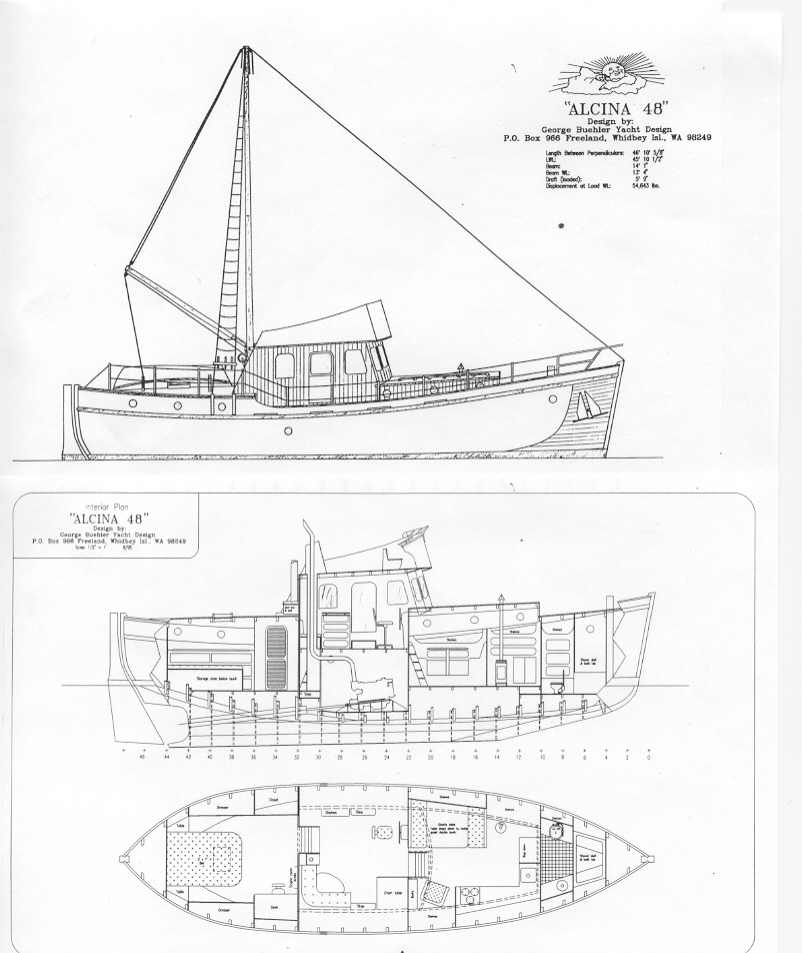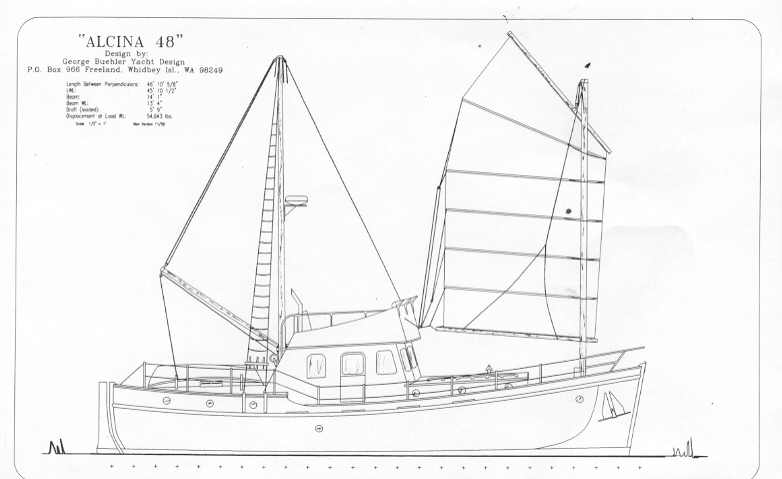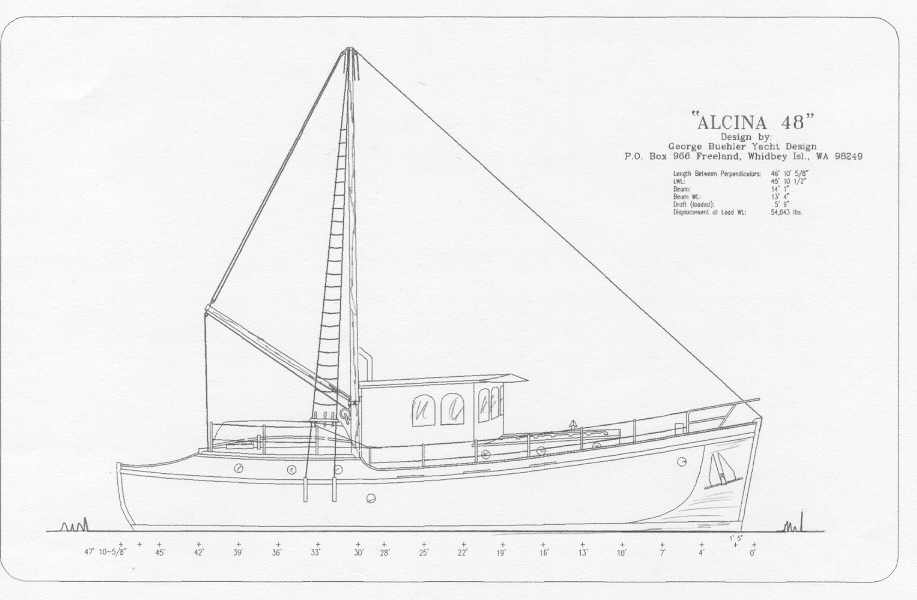Optional Junk backup sail plan looks great and would be very practical off the wind.
Here’s a version I sketched up in 2004 showing her with a small cockpit aft and a more traditional wheelhouse. I like this look but she needs a flybridge of course!
I think ALCINA is an ideal long term cruising live aboard for two, with plenty of living and storage space. She started out as a spec design, based along my ideas of what I would like to own. The original was 42′ but I was never really happy with it because I wanted just a bit more elbowroom inside. 42′ would do the job, and was small enough so that “RUTH,” my wonderful 900 pound Lister 36 HP STW diesel, with back-up hand start, compression releases, big flywheel, and 3:1 Lister built super heavy duty mechanical transmission, would power it OK except of course head on into a real blow which I wouldn’t be apt to do anyway.
However, when a guy in Canada decided he wanted to build ALCINA, I suggested we stretch her out to 48 feet because that extra few feet makes all the difference in the interior and really doesn’t add much to the actual materials costs. The one problem might be “Ruth.” I’m not sure if she’ll have the guts in a boat this displacement although since most of the time you’re powering with the weather, normally she’ll work.But the plans show 80 to 110 HP, which will power her in most conditions yet still idle down fine for off-wind passage making.
ALCINA is an example of what I call (in case you haven’t heard me say it yet!) the PRACTICAL long range power cruiser, and like any other specific use tool, is designed along guidelines that are necessary to do the job.
Even though double ended power boats aren’t often seen these days, I’ve always liked the look so ALCINA is double-ended.Traditionally that style is thought of as the most seaworthy type, but that probably comes from the days when boats were launched from shore and had to be maneuvered backwards in surf. Transom hulls, when the transom is actually out of the water and the bow of the hull is also somewhat full, seem equally seaworthy, and have more room inside for their length. They just don’t have”That Look.”
I’m going to avoid quoting formulas or ratios or other engineering jargon as much as possible since descriptive adjectives are often better when discussing a subject as UN-precise as boat design, unless you are both a graduate of MIT and a poet. There is nothing”extreme” about this boat; she’s “moderate.”She has good beam but not to much. She’s deep enough to get the volume to have sufficient displacement to support hefty scantling sand a good payload but she isn’t so burdensome that she would need huge power to plow through the water. She has enough freeboard to be dry on deck and to give you a secure feeling of being inside a “little ship.” The underwater hull lines are “crisp”and “clean” without protrusions or bulges. The above water hull lines are smooth and flowing. The resulting hull not only slides easily through the water, but is easy to build because materials wrap on without undo force.
The prop and rudder are fully protected by the keel. While she could have a normal inboard rudder, I gave her a big outboard rudder. I like outboard rudders because they are so simple and because they don’t require another hole through the hull.I think that their width adds to the WL length so helps the boat move easier. Most people disagree with me here, but there’s no doubting that the outboard rudder IS adding 2′ or more to the length of the hole in the water the hull makes, and something besides good karma is allowing my little 38′ DIESEL DUCK design to cruise at about 8 knots while burning less than a gallon an hour, as her owner swears the boat will do. The big “barn door” rudder gives the boat steerage even when it’s hardly moving. There’s nothing new or radical about this hull. It’s based solely on principals worked out and understood by the last century, adapted to low power engine driven craft and then perfected by 1930.
I like the appearance of this boat, but it’s based on more things than appearance. The interior is divided up into three areas: owner’s private cabin in the stern, a wheelhouse with engine room below located about in the middle of the hull, and a forward living cabin. These are distinct areas and their function in part forces the basic profile appearance to look as it does. I’ve found it makes sense in all sizes of cruiser which is why I’ve even used it in the preliminary sketches of the102 footer I’m working up at this writing. This sounds rather unimaginative but if you look at boats you’ll note that most sailboats have one long house, and most powerboats share one of several basic looks. The “art” comes into the design with the drawing of the sheer, and the way the various parts are proportioned and placed.
The aft third or so of the hull is raised sheer and flush deck.This gives a very spacious interior below, as well as a large lounging deck topsides. Look at that aft cabin! It’s 14 feet long and features a 5′ x 7′ queen sized bed. There’s also book and clothing shelves, and a writing desk. This is the owner’s “private area” and is more like a shore-side bedroom than a yacht “stateroom.” Topsides there’s room to carry a large skiff, a couple bikes or motorcycles, deckchairs, and so on. Deck space for a substantial skiff is important for a cruising boat, yet most new designs, sail or power, can’t do it. A normal deckhouse could be used instead of the raised sheer, but you’d loose both the spacious feel inside and the big “working” deck area and couldn’t carry much of a skiff. Note the mast. While primarily meant for carrying sail which is used for steadying the roll and for serving as a”riding sail” at anchor or when hove-to, when cruising off the wind (which you’ll normally do), the small sails can also offer some help to the engine, greatly increasing fuel economy and of course range. And equally important, they provide a 100% dependable, very low maintenance, and quite inexpensive, emergency propulsion system. Briefly, you’ll never be left dead in the water. You may not be able to point right where you wanted to go, but you will always be able to get to land. The mast and boom is also used to hoist your skiff and motorcycle aboard.
The midship area has a comfortable wheelhouse, high enough for good visibility as well as giving good headroom in the engine room below. The wheelhouse is short by “normal” new power boat standards but keep in mind we’re discussing a boat designed for long range cruising. We need a wheelhouse that is primarily a wheelhouse, not the galley or main lounge area too. If you want to be able to see out the windows when you drive the boat at night you need to have it dark inside the steering area. If the wheelhouse is also the galley or main lounge you’ll have to give up either driving at night, or cooking and sitting around in the light. The wheelhouse doesn’t have to be very big if it’s just a wheelhouse. The main practical considerations are to provide a comfortable area to drive the boat from, and an engine room big enough to easily maintain the systems. The engine room is normally below the wheelhouse. ALCINA’s 10′ of floor space in the wheelhouse is very spacious and gives a wonderful engine room with lots of space to get to the engine.
From a sailboater’s point of view those big windows in the pilot house look dangerous. I suppose they could be, but that can be dealt with by carrying “shutters” if you expect terrible weather. A steel house welded to a steel deck isn’t going anywhere even if capsized, but if I built one of these boats in wood I would likely make the wheelhouse floor totally watertight, with a few cockpit style drains in it. Entrance to the front and rear cabins could be sealed off with sailboat style drop boards and sliding hatch, and in a worst case scenario of actually staving in part of the house or more likely, thinking it COULD happen, you’d have a good chance of avoiding sinking. A little paranoia can guarantee a long and happy life! I have seen a couple trollers come in with their forward windows knocked out, and my friendBill has lost them in his 100 foot crab boat up in the BeringSea. But like most accidents at sea, this normally can be avoided if rather than pushing on in very bad weather, you heave-to and drift.
The forward cabin hosts the galley, dining area, and head. The galley is large enough to comfortably and easily cook real meals.The dinette table converts down to make a guest bunk for company.Note the large head with separate shower stall. This cabin could be raised sheer and flush deck like the stern, but I like a normal deck house here. The side decks rob room from the interior but the house, but with a hand rail on each side of the roof, makes movement forward easier.
This interior is planned out exclusively for the comfort of the owners for spending long periods of time aboard, but will accommodate2 occasional guests. Of course, you can change the interior if you want to; that’s part of the appeal of building a new boat since you can set it up to fit YOUR needs. But this interior would be very comfortable, and I can’t think of a better long term cruising home layout!
Construction is simple and quite stout. She’s much stouter than most yachts anywhere near her size use. ALCINA’s wood hull is “composite” construction. There are heavy frames on 24″ centers, then the hull is planked with a layer of3/4″ x 3″ wood, covered with three layers of 3/8″plywood. The finished 1 7/8″ thick laminated hull is sheathed with fiberglass cloth and coated with epoxy. While this style of construction doesn’t have the abrasion resistance of steel if it ends up on a reef some night, it is still extremely stout and very low maintenance. Plans are also being developed for steel construction, based on 1/4″ plate for the hull.
Finally, I love “flying bridges.” Surveying the world from up there gives a guy the feeling that he is indeed “captain”of a ship. You can easily start pretending that you are at the con of the BISMARCK or some other mighty craft. It doesn’t add much to the cost, but does increase windage a little. You don’t have to build it on, but I would!
The first of these designs was built in Canada of wood by Fred Hammond, in less than 3 years. She worked outwell but unfortunately a year later was destroyed by fire; a terrible thing. But Fred got over it, and is talking about building another boat…. Here’s a couple pictures. She needed a heavy rub rail and a flybridge (!) but otherwise, she looks great. She’s a fine example of what a determined homebuilder on a “reasonable budget” can accomplish.
It’s interesting that the steel boats have been sitting low but wood, proportionally as stout (this is one STOUT wood boat!) is noticeably lighter. She’s floating a good8″ high in these photos and is loaded pretty well. There’s nothing wrong with using ballast of course!
The type of cruising sailboats that were common up to the early 1970’s; simple, stout, reliable craft, designed and built to safely cruise the oceans without hassle, are out of fashion today and aren’t talked about in the marine press at all anymore. Because they were simple and straight forward, they weren’t all that expensive and a young guy or especially a working couple could build or buy one, and have it paid for before they were to feeble to use it.
ALCINA is the same sort of idea. You don’t see much mention of the type in today’s marine press because there isn’ta great deal of advertiser’s products involved in them, so you’ll need to be able to decide for yourself whether or not you agree with the concept. I know it can be hard to makeup your own mind without the help of the popular press to guide you, and many of the folks at the yacht club bar won’t understand it. But this sort of boat, like it’s sailing cousin based on the same philosophy, makes lots of sense regardless of your financial situation. Although it happens to be an affordable concept don’t let that make you think its somehow second rate. Quite the contrary.
 A full “Junk” rig drawn by Tim, who still might build her!
A full “Junk” rig drawn by Tim, who still might build her!
PARTICULARS
LOD: 47’6″ … LWL: 45′ 10″ … Beam: 14’1″ … Draft: 5′ 9″ … Displacment:54,643 lbs.
Coefficients:
Prismatic:.612 Block: .248 Waterplane: .716 Midships:.403
Ratios:
L/B:3.38 … D/L: 266 … Lbs./In.: 2298
Suggested Power: 80 HP minimum
Estimated Speed/HP Required/Range with650 Gallons (min. suggested) Fuel, Calm Conditions
|
V/L…..Knots…….Estimated HP…….Estimated Range (miles) 1.1……7.45…………12.8………………. 6305 |




